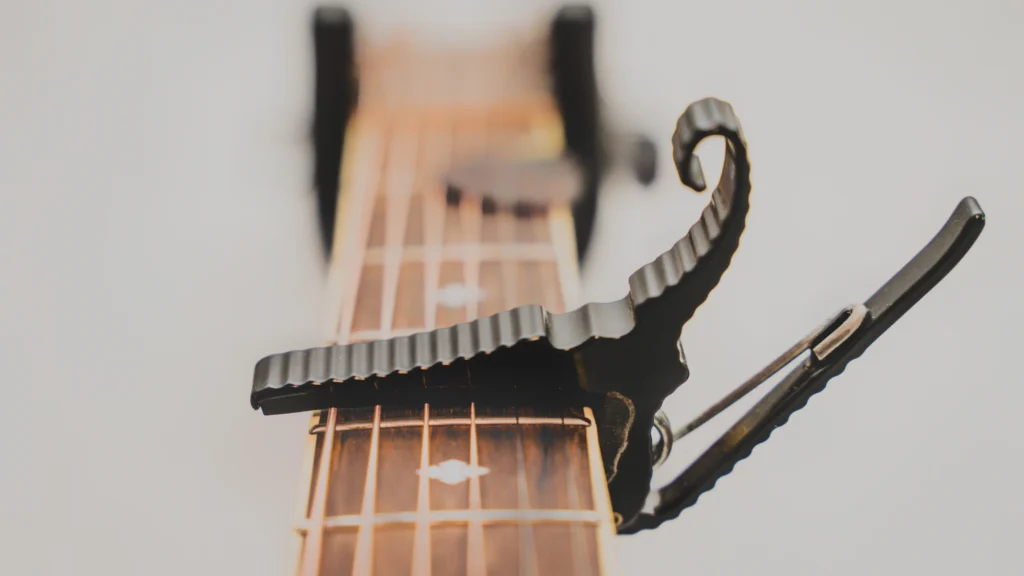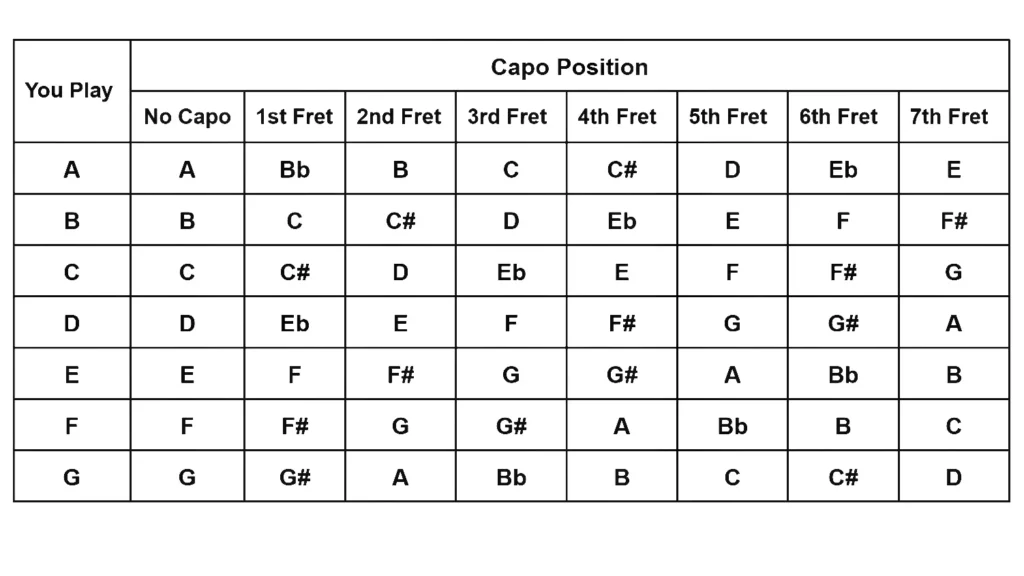If you’re a guitarist looking to expand your playing capabilities, a guitar capo is a must-have accessory. The use of a capo can open up a whole new world of musical possibilities, regardless of whether you play an acoustic guitar or an electric guitar.
There are so many different types and positions to choose from that it can take time to know where to begin. That’s where this guitar capo chart comes in handy.
Here, I’ll break down the different types of capos and their functions, as well as provide a comprehensive chart that shows you exactly where to place your capo for each key.
So grab your guitar and get ready to take your playing to the next level with our guitar capo chart!
What Is A Capo?

A capo, in its most basic form, is a mechanism that bars or holds a bar on a certain fret on an acoustic or electric guitar. The capo acts as a new nut position on the guitar neck, changing the tuning and allowing you to play different chords without making any physical modifications.
There are three types of capos available on the market:
- Trigger Style
- Yoke style
- Strap style
Trigger Style
Capos with triggers are the most prevalent. The capo opens up with a simple press on the handle, and you slide it to your chosen location on the fretboard before releasing the squeeze to set it on the Fret. These capos bite down on the string with spring tension.
The most typical user error is adding a side load to the string as you release, causing a bend; nevertheless, it is simple to ensure the string surface is touching before carefully releasing the handle. When not in use, the capo detaches effortlessly and can be fastened to a music stand, placed in a case, or clipped to the head of your guitar.
Yoke-style Capo
A yoke-style capo wraps completely around your guitar’s neck and is secured by a single screw on the back. This capo is normally left on the tuning peg side of the nut of your guitar.
When you’re ready to use it, loosen it and slide it over the nut to the Fret you wish to capo at, then tighten the rear handle. Some guitarists favor this capo because it is uniformly tightened, while others dislike how it feels more permanent on the fretboard when it is screwed down.
Strap-style Capo
The strap-style capo consists of a metal or wood rod and a strap that wraps around the guitar’s neck. These capos are often inexpensive and made of elastic, cotton, or other strap materials. They are notorious for wearing out with time as the straps stretch and must be replaced frequently.
A lot of it comes down to personal preference when it comes to choosing a capo.
What is a Capo Chart?
A guitar capo chart might assist you with your guitar playing if you are new to utilizing this product. The guide includes thorough information on the new pitches you can achieve, as well as each sound produced by the Fret you grip. Each root note has a separate chord with a different capo placement on the guitar neck.
If you want a more literal explanation, a comprehensive capo chart shows how a guitar capo works. It, as previously said, lists the notes to be played as well as the location of the device. Many songwriters use it to develop a key change, and many cover artists use it to adjust the pitch of a song.
If you wish to change the pitch uniquely, there are other guides available. The Drop D chart, which is common in rock music, is one of these. Another popular technique is the half step, which allows artists to perform in a lower key without totally altering their strings.
A guitar capo handbook is accessible both digitally and on paper. You can create it yourself or download it from a reputable internet guitar specialist. If you’re a newbie, you can start with this alternate guitar tuning chart. You want to make certain that the information you utilize is correct.

How Do You Read A Capo Chart?
It may take time to understand a capo guide. You might need help to figure out how these letters and numbers are put together.
As was already said, the chart shows how normal pitches change when a capo is on a certain fret. Each row has information that shows how single notes change. The new notes that are made when you clamp your capo to a certain spot on the neck are shown in the vertical sections.
If you choose to make your capo chart, you can be sure that it won’t need to be changed once it’s done. Notes in music don’t change over time. It will also help you remember where to put your capo for different sounds and recognize pitches better.
But feel free to look at your map while you’re learning. You can only expect to remember some notes and changes, especially since you just started learning guitar. Think about how your skills will keep getting better as you practice with your capo guide.
How To Use a Guitar Capo Chart?
Just pick out which fret you want to use your capo on to put it on. As you learn new songs that need a capo, make sure you know which fret to put the capo on. For instance, “capo on 2nd fret” or any other place you need to put the capo is shown on guitar tabs and chord diagrams.
The capo should cover all the strings on the same Fret unless it’s a partial capo. Then, use whatever method is offered to make your capo tighter. After putting the capo on, strum the guitar to make sure that each string sounds good.
Putting a capo on your guitar can sometimes cause fret buzz. If this happens, fix the capo again. Try not to slide the capo up and down the strings when you move it. Instead, take the capo off and then put it back on. This will keep the strings from getting worn out.
How Does A Capo Chart Work?
To begin, playing the strings that go with the notes that a song usually needs. Check to see if the music lets you make small changes and still remember the original pitches. When you first look at your guitar chords and capo chart, use these as a guide.
Find the notes you played on the guide the first time. Check out what pitches you can reach with a capo. You can play any of them on your guitar to get a feel for the sound you like and want to achieve.
When you find the right pitch, look at your chart to see where the capo should be on each guitar neck. Place your device over the Fret that the book tells you to use to make a new note. Press down on the original strings to see if you can get the sound you want.
If the notes need to be corrected, you should fix them. You can move your capo to different frets to hear if a different pitch sounds better. You should keep making changes until you get the sound you want for the song you want to cover or make.
Should a Beginner Use a Capo?
Some people who are just starting to play the guitar might wonder if they need to use one of these items. One good thing about capo chords is that they make learning less stressful. Because you can move the clamp to different notes on the chart, you will need to remember fewer chords.
One more thing that can help you if you want to become a musician is a capo. By adding a clamp to a fret, you can change the sound of any song totally. It can help you sound like a great new artist, even if you’re starting.
You can also write a song for someone else’s voice with cops if you’re starting. A lot of singers will need the music to be in a different key. If you and your band play cover songs, this might happen more often. With a capo, you can do this job more easily without having to move the song around.
Lastly, a capo can ease the pain of playing the guitar. Some people who are just starting to learn an instrument give up because their fingers hurt. Strumming puts less stress on your left hand because it doesn’t have to work as hard. When a capo is on the neck, some guitarists like to use barre chords.
Tips To Use Guitar Capo
Capos can be used as a guitar nut that can be moved or as a finger that holds down a barre chord. Remember that and think about how to make chords around it. The same idea applies when using the capo on minor notes.
To show this, let’s change an A minor chord to a B minor chord. Just put the capo on the second Fret and move the A minor chord up one step. You now have a chord in B minor.
When you capo the frets, the strings get shorter. To put this into perspective, longer strings have a lower frequency, which means a lower pitch and shorter strings have a higher frequency, which means a higher pitch.
It will give you G, C, E, and A when you play from low to high with your capo on the 5th Fret. A Soprano, Tenor, or Concert Ukulele sounds a lot like this, but there’s one big change. The lowest string on a guitar is the G string, but the lowest string on a uke is the A string.
If your guitar needs to be tuned right, moving your capo up the neck will make it more and more out of tune. With cops, you can hear if there are any problems with your pronunciation.
Final Words On Guitar Capo Chart
A guitar capo is a versatile tool that can greatly expand your playing capabilities on the guitar. By using a capo, you can easily change the pitch of your instrument without having to learn new chord shapes or transpose music.
You can use a capo to add variety to your playing, whether you’re a beginner or an experienced guitarist. I’ve created this guitar capo chart to help you confidently use this tool and unlock new possibilities in your guitar playing.
So grab your capo, explore different positions on the fretboard, and let your creativity soar. Rock on!
FAQs
What Key Is Capo's 2nd Fret?
D is the capo’s 2nd Fret. The capo on the second Fret moves us up two-half steps from C. The key of D would be C and D. The chords C, F, and G will sound like D, G, and A when played with the capo on the second fret.
What Is C Capo 1 On Guitar?
Every Fret on your guitar corresponds to one note in the chromatic sequence. The note in the sequence following the C chord would be C#/Db, while the note in the sequence following the C chord would be D#/Eb.
What does capo 7th fret mean?
The capo on Fret Seven gives the guitar a bright, mandolin-like sound. With the capo on, the chord progression comes out in the key of A major instead of D major.
